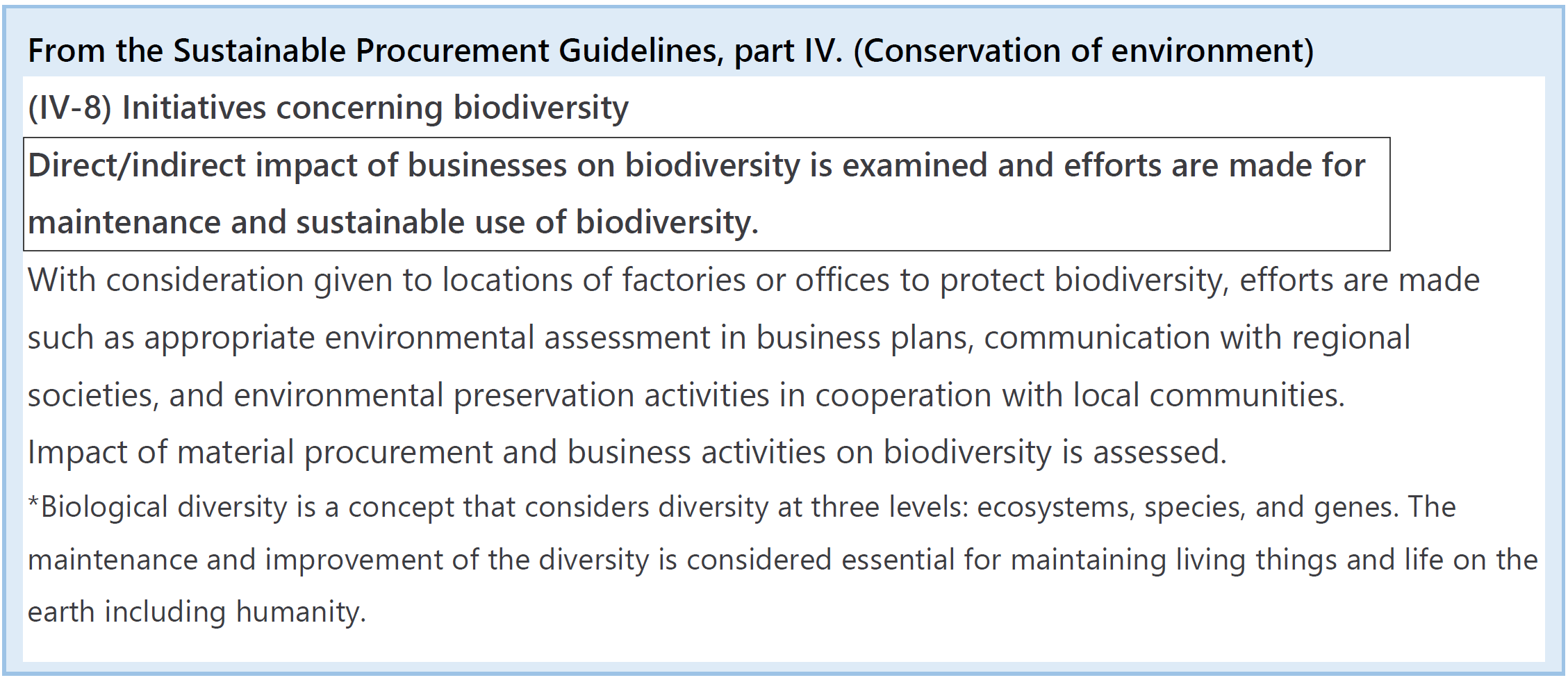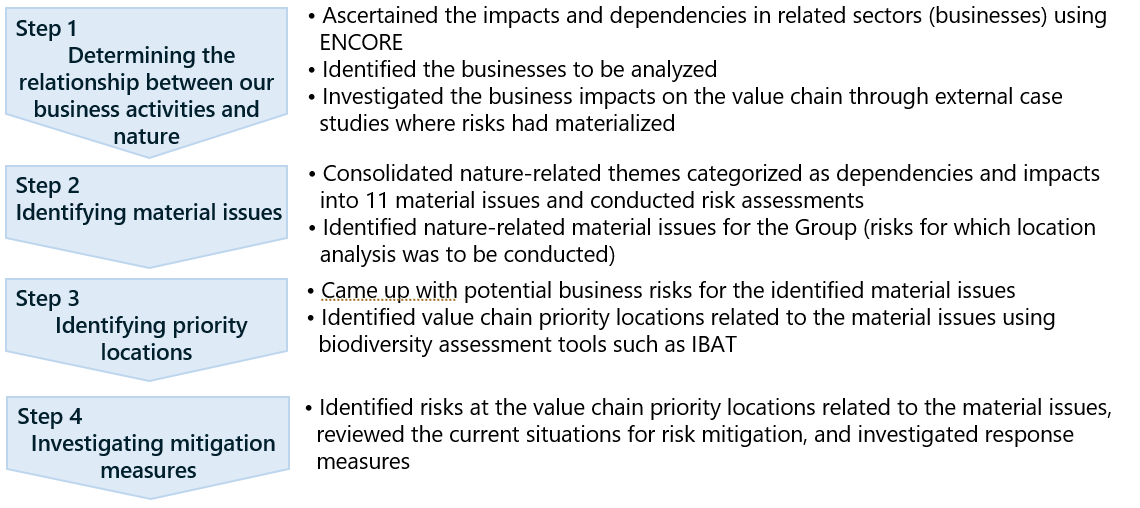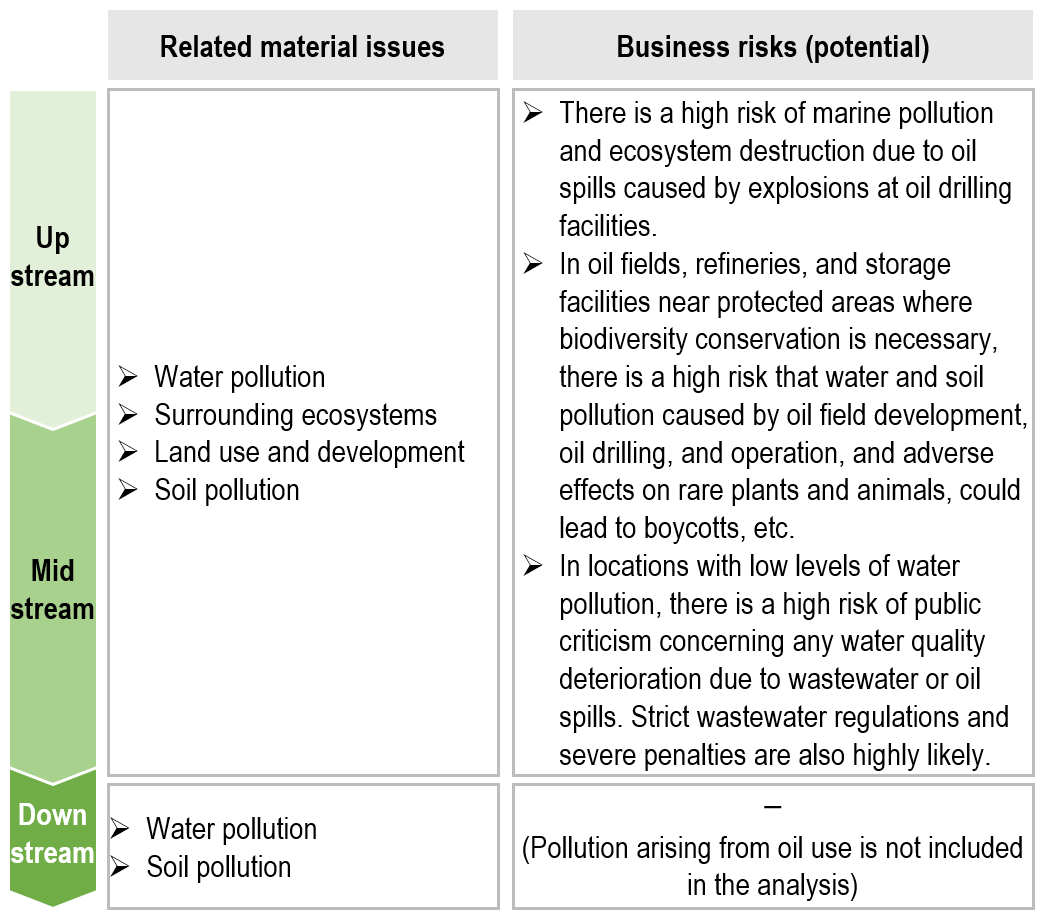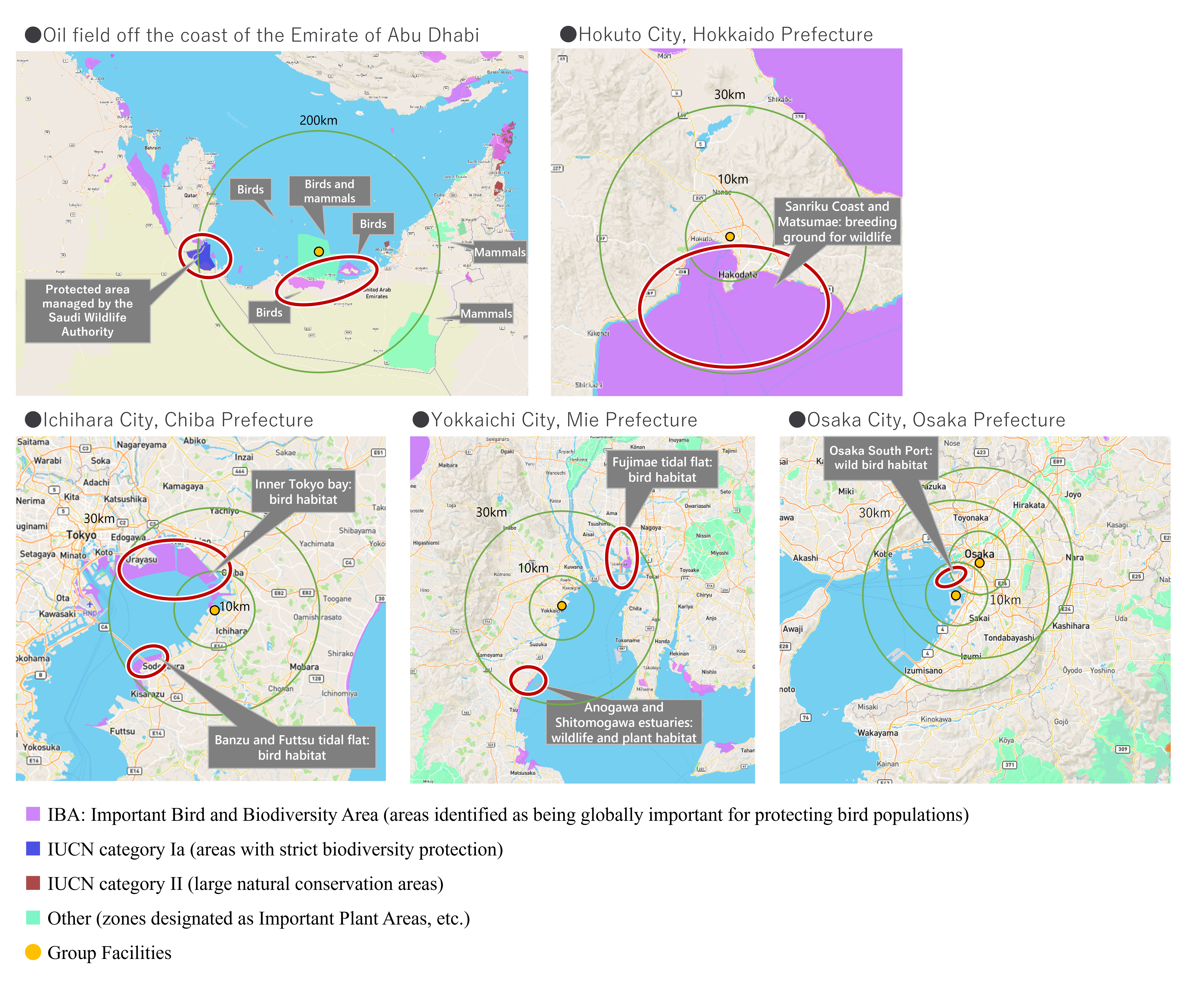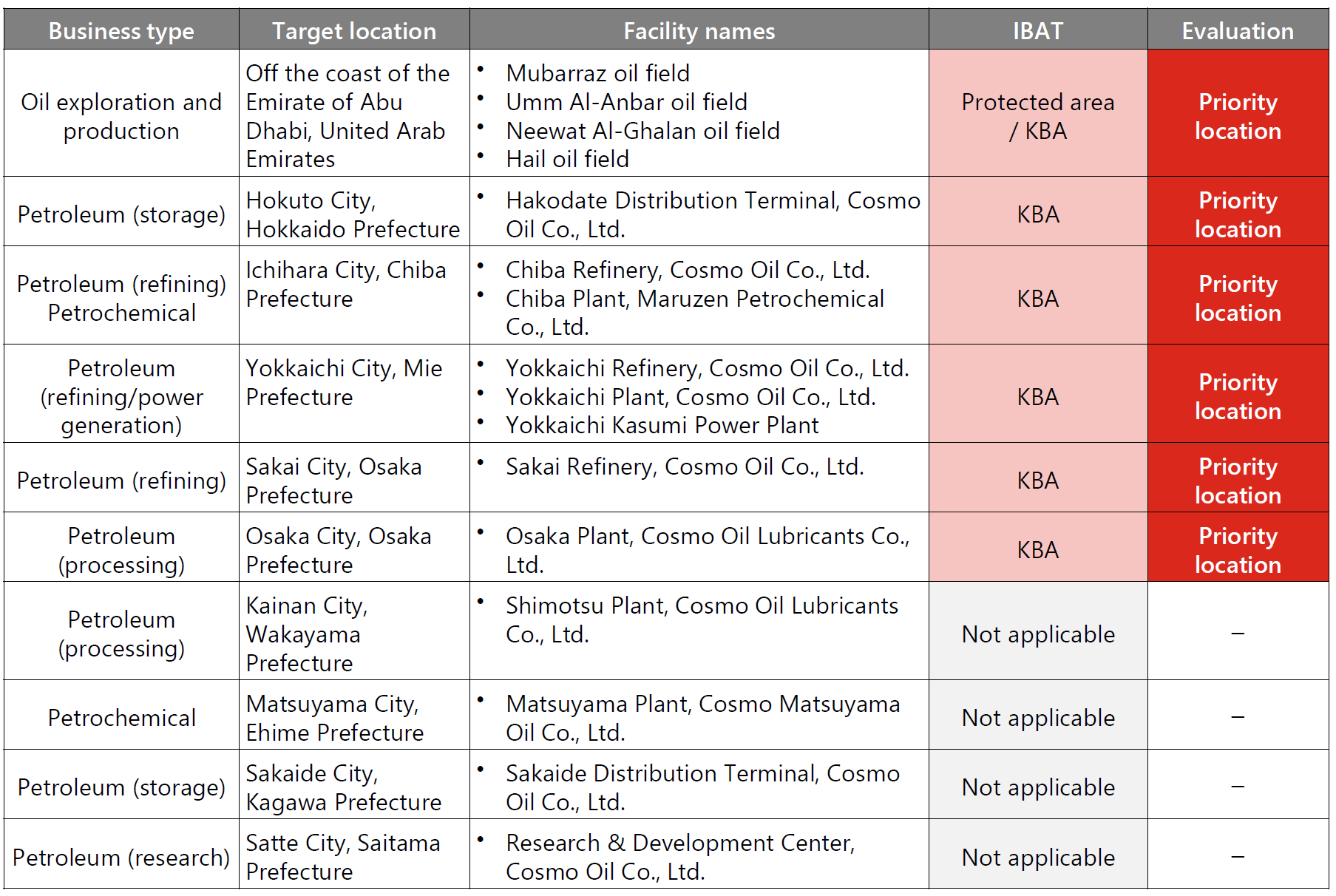Approach to Natural Capital and Biodiversity Conservation
While working to develop and provide petroleum products, the Cosmo Energy Group also engages in initiatives such as renewable energy operations, biodiversity conservation, and sustainable use of natural capital. We are focusing on various activities to help preserve the global environment as a priceless inheritance for future generations.
Based on the Group Management Vision, “In striving for harmony and symbiosis between our planet, man and society, we aim for sustainable growth towards a future of limitless possibilities,” the Cosmo Energy Group is striving to realize its Basic Concept of Sustainability, including “Harmony and symbiosis with the global environment.” The Group’s Code of Conduct states that officers and employees must take measures to mitigate climate change, minimize environmental impact, conserve water and marine resources, and enforce rigorous soil preservation measures. We also have an Environmental Policy in place to ensure that all our business activities are conducted in harmony and symbiosis with the environment.
Cosmo Energy Group’s Environmental Policy
The Group’s Environmental Policy includes a basic approach to the conservation of natural capital and biodiversity. Under this policy, we are committed to environmental preservation as well as the conservation and improvement of biodiversity, as we seek to make effective use of resources and sustainably use natural capital.
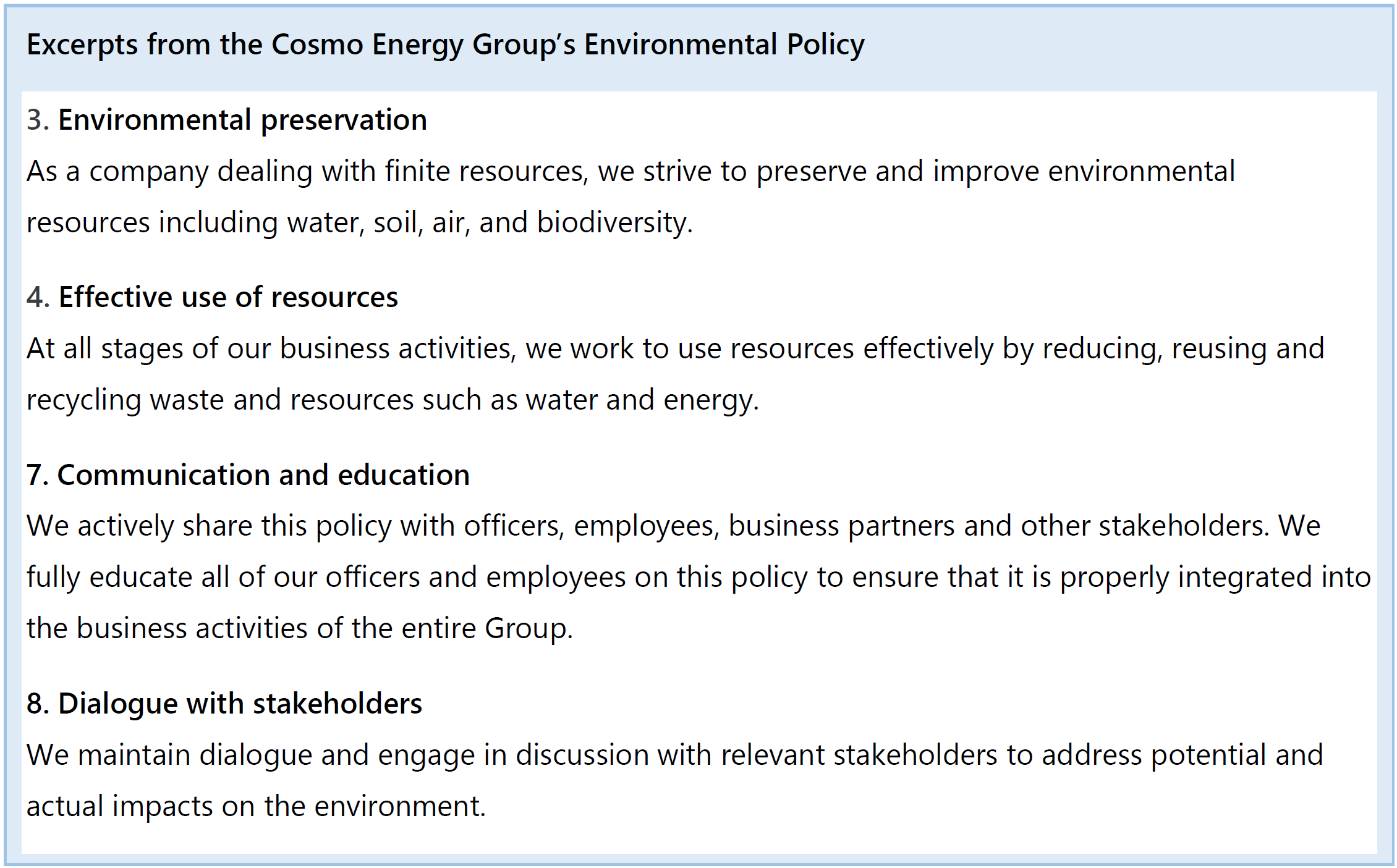
To date, the Group has been working to reduce factors that affect the natural environment by striving to minimize its environmental impact. These efforts include climate change countermeasures, pollution prevention, chemical substance management, as well as circular economy efforts and resource conservation.
To further promote these initiatives, we participate in initiatives based on the Declaration of Biodiversity by Keidanren (Japan Business Federation) and the 30by30 Alliance for Biodiversity. Accordingly, we implement initiatives to conserve ecosystems and take biodiversity into account across all of our business activities.
The Group also participates in the TNFD Forum, which involves organizing and disclosing past activities in line with the TNFD framework. We are also working to conserve the natural environment, including biodiversity, by properly assessing and disclosing risks and opportunities related to natural capital and biodiversity across our entire value chain.
For more details on our collaboration with external organizations, please refer to “Initiatives Endorsed and Supported, Participating Organizations.”
Keidanren Biodiversity Declaration Initiative
Participation in the 30by30 Alliance for Biodiversity
Participation in the Taskforce on Nature-Related Financial Disclosures (TNFD) Forum
Responding to the Recommendations of the Task Force on Nature-Related Financial Disclosures (TNFD)
The Taskforce on Nature-related Financial Disclosures (TNFD) has developed a set of disclosure recommendations for organizations. These guidelines call on companies to identify and disclose their nature-related issues, namely their impacts and dependencies on nature as well as the relevant risks and opportunities, which can affect their business strategies and financial plans. The recommendations also urge companies to use specific indicators to assess and monitor their impacts on nature.
In response to these guidelines, the Group has ascertained its relationship with nature. We did this by conducting a trial risk assessment and analysis of our business impacts based on the TNFD Recommendations Version 1.0, released in September 2023.
With existing environmental data, we conducted a trial risk assessment of our nature-related dependencies and impacts using the LEAP approach (Locate, Evaluate, Assess, and Prepare) recommended by the TNFD. This assessment incorporated the necessary indicators for issue evaluation and management, including the nature-related material issues set by the TNFD, the geographical specificity of the Group’s business sites, and the upstream and downstream portions of our value chain.
Nature-Related Governance
System for Monitoring (Oversight) by the Board of Directors and Role of Senior Management
Chaired by the Representative Director and Group CEO, the Sustainability Strategy Committee deliberates on matters concerning important operations and policies, including nature-related issues. Matters deemed to have a major impact on the entire Group are discussed and reported to the Board of Directors, thereby ensuring appropriate oversight by the Board.
Please refer to the link below for more information on the agendas of the Sustainability Strategy Committee meetings and the Committee's reports to the Board of Directors.
Stakeholder-Related Governance
The Group recognizes that engagement with those particularly affected by environmental degradation and pollution, such as indigenous peoples and local communities, is an essential part of coexisting with nature. We consider this engagement to be one of the key themes in the analysis of nature-related risks and opportunities.
■ Approach and Initiatives for the Human Rights of Indigenous Peoples and Local Communities
The Group’s business activities have an impact on a range of important human rights issues. One of these is respect for the lands and rights of indigenous peoples, and this is clearly stated in our Human Rights Policy. As part of our human rights due diligence, we evaluate the actual and potential risks as well as relevant management systems regarding indigenous lands and rights. We also have a process for investigating corrective measures as necessary.
For details, please refer to “Basic Approach to Human Rights.”
■ Supply Chain Approach and Initiatives
Based on our Sustainable Procurement Policy, we have created the Cosmo Energy Group Sustainable Procurement Guidelines. They outline specific efforts to be carried out for the supply chain in nine areas: (1) Fair trade and ethics, (2) Human rights and labor, (3) Disaster prevention and safety sanitation, (4) Conservation of environment, (5) Quality and product safety, (6) Information security, (7) Contribution to society, (8) Business continuity plan, and (9) Supplier management.
In the area of conservation of environment, we share our biodiversity initiatives and ask that our business partners (suppliers) understand and support them. We also require them to take action in accordance with our guidelines.
Please refer to the link below for more information.
■ Management and Reporting System
Various investigation results based on the Sustainable Procurement Guidelines are reported to the Sustainability Strategy Committee, including findings from biodiversity risk assessments, human rights due diligence activities, and supplier assessments. Information deemed especially important is also reported to the Board of Directors.
Risk and Impact Management
Identification and Assessment Process for Risks and Opportunities Related to Nature-Related Dependencies and Impacts
■ Assessment Process
First, we identified the degree of our dependencies and impacts on nature and the relevant risks based on information from ENCORE,1 before investigating external cases where relevant risks materialized. We then identified our material issues based on the results of this investigation.
Next, we used tools such as IBAT2 to identify priority locations3 in the value chain for each issue and the material issues for each location. Finally, we checked the situation for mitigation measure implementation at the priority locations.
1 ENCORE(Exploring Natural Capital Opportunities, Risks and Exposures): Risk assessment tool to determine the magnitude of a company's impact on and dependence on nature.
2 IBAT:Database developed by the IBAT Alliance, a biodiversity project involving the United Nations Environment Programme (UNEP) and others.
3 Priority locations: TNFD-defined 'areas requiring attention’ or high-risk areas
Nature-Related Risk and Opportunity Management Process, and Group-Wide Risk Management
■ Risk Management
The Group has positioned “strengthening of Group risk management” as one of its material issues. It has established a system to identify all potential risks relating to business activities, appropriately manage various risks, and minimize losses. We are striving to enhance risk management using a cycle of planning, implementation, evaluation, and corrective action.
■ Management System and Processes
Please refer to the link below for more information on risk management at the Cosmo Energy Group.
Impact of Nature-Related Risks and Opportunities on Business Activities
Key Nature-Related Risks and Opportunities
■ Ascertaining the Relationship between the Group’s Business Activities and Nature (Dependencies and Impacts)
In response to the TNFD Recommendations, we listed the nature-related risks and opportunities in the Group's business areas: oil exploration and production, petroleum refining and sales, petrochemical products, electricity, and renewable energy. Using a risk assessment tool (ENCORE), we assessed the significant nature-related dependencies and impacts for our relevant businesses, categorized by nature-related themes. A heatmap was then generated using the results.
Heatmap of the Group’s Nature-Related Dependencies and Impacts
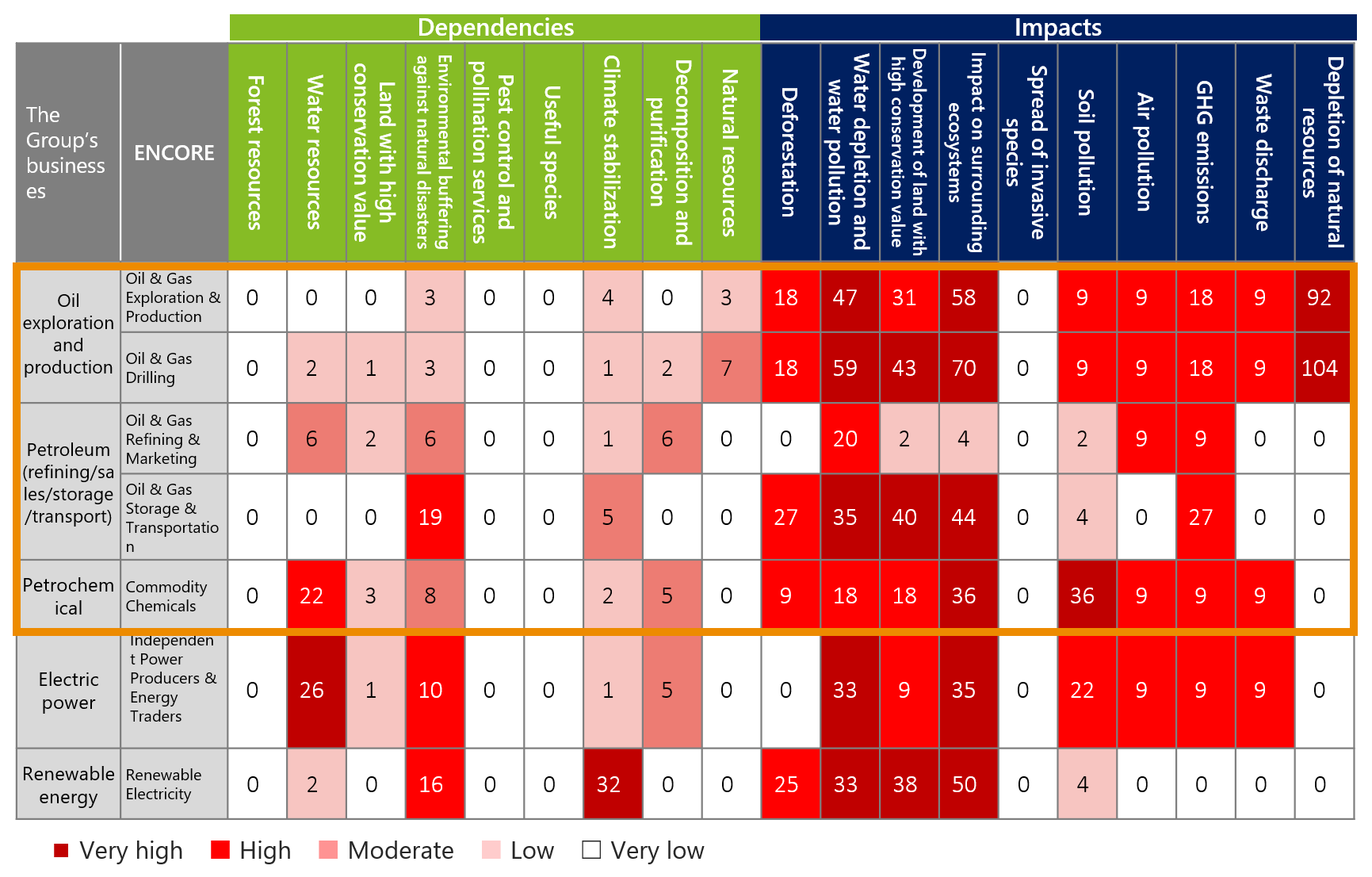
Note: The figures were generated by quantifying the ENCORE risk categories using five levels, and adding up the points for each category. The higher the number, the greater the level of impact.
Based on these results, we made an initial step to comply with the TNFD Recommendations. We selected our oil exploration and production, petroleum (refining/storage), and petrochemical businesses as targets for analysis in line with the LEAP approach.
Nature-Related Materiality Map
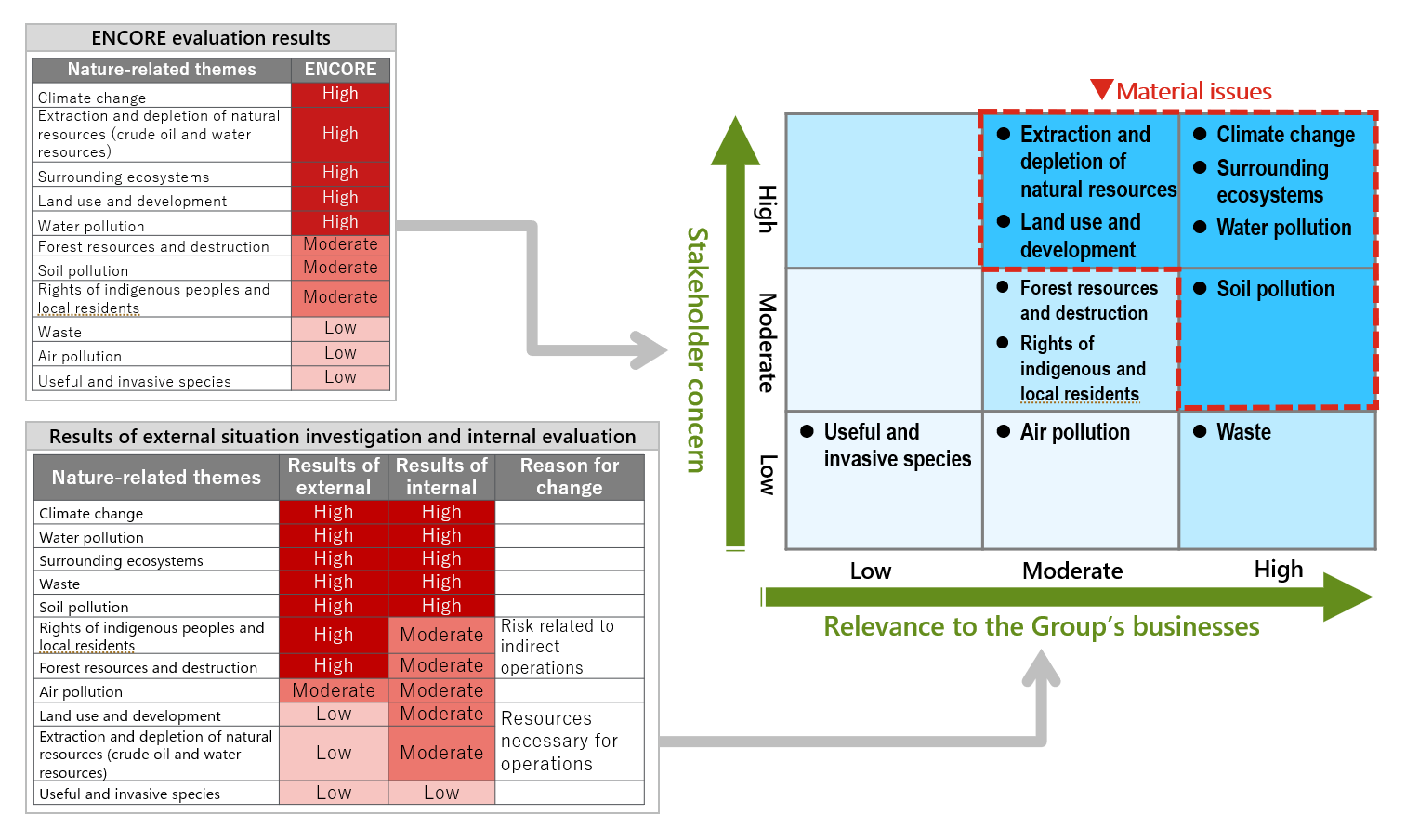
■ Selection of Nature-Related Material Issues
In addition to evaluating our dependencies and impacts using ENCORE, we identified our material issues. We did this by investigating examples of business risks in the value chain, such as new regulatory trends and potential stakeholder criticism of the Group for its impacts on nature. We also specified the relationship between relevant nature-related themes and our value chain.
Using the findings of these investigations and analyses, we evaluated the results using a graph. The scores from the ENCORE analysis of nature-related risks were plotted on the vertical axis as “stakeholder concern level,” while the results of our risk importance assessment were plotted on the horizontal axis as “relevance to our business.” We then added the theme of “rights of indigenous peoples and local residents” to this, and visualized our nature-related risks using a materiality map.
With this materiality map, we identified six nature-related material issues for the Group: climate change, surrounding ecosystems, water pollution, extraction and depletion of natural resources, land use and development, and soil pollution. We then conducted a location analysis.
Location Analysis for Material Issues
■ Business Risks Related to Material Issues
To enable investigation of response measures for the Group’s nature-related material issues, we needed to perform location analysis. Based on their positions in the value chain, we identified operational sites with high potential for material issue risks, and conducted risk assessments for those sites.
As part of material issue analysis, we conducted a location analysis using the scenario of a crude oil or petroleum spill at a major site operated directly by the Group. This was based on the assumption that such an oil spill would have an especially large business impact, making it a significant risk.
In addition, we excluded the two material issues of “climate change” and “extraction and depletion of natural resources” from the location analysis because there are no regional differences and freshwater intake is low for relevant sites.
Value Chain and Nature-Related Material Issues and Business Risks
■ Specification of Priority Locations for Material Issues
When assessing the impact of a potential oil or petroleum spill, we checked for areas of biodiversity importance within a radius of 200 kilometers from the Group’s main offshore oil fields, and within 30 kilometers of our coastal operation sites in Japan.
Coastal and Offshore Sites
Using the IBAT biodiversity risk measurement tool and the marine habitat distribution tool Ocean+ Habitats,4 we assessed our biodiversity risks and conducted a priority location analysis of areas deemed to be particularly susceptible to natural impacts. As a result, we found that the areas surrounding six Group sites, one located off the coast of the Emirate of Abu Dhabi, as well as others in Hokkaido, Chiba Prefecture, Mie Prefecture, and Osaka Prefecture, include some areas of biodiversity importance.
4. Ocean + Habitats: An online provider of information on marine habitats worldwide, including their health, distribution, and recent changes. It also offers practical data useful for the conservation and restoration of marine ecosystems./span>
Location Analysis Examples (IBAT)
Inland Sites
Using the biodiversity risk measurement tool, IBAT, and the water risk assessment tool, Water Risk Filter,5 we evaluated nature-related material issues for sites directly operated by the Group and identified our priority locations. This was done based on information such as areas of importance for biodiversity and surrounding water pollution levels.
As a result, we determined that none of our inland sites have any areas of importance for biodiversity within their vicinity.
5. Water Risk Filter: An online tool developed by the World Wide Fund for Nature (WWF) and a German company to evaluate water risks near corporate sites
Based on the above results, six sites, including the area off the coast of the Emirate of Abu Dhabi and five sites within Japan, were identified as priority locations. This was due to the presence of priority areas in terms of biodiversity, water pollution, soil pollution, and coral and mangrove habitats.
Evaluation Based on Value Chain Location Analysis
Note: Key Biodiversity Area (KBA): Important area for biodiversity conservation
Investigation of Response Measures
■ Responding to Material Issues
At the six sites identified as priority locations, we assessed the risk of environmental impact from an oil spill, which would have a large impact on society and consequences for business continuity. We confirmed that the sites have already implemented various measures at this stage, including impact mitigation strategies based on past incidents and spill prevention measures. If any changes occur in operations or the surrounding environment going forward, we will consider additional response measures as necessary.
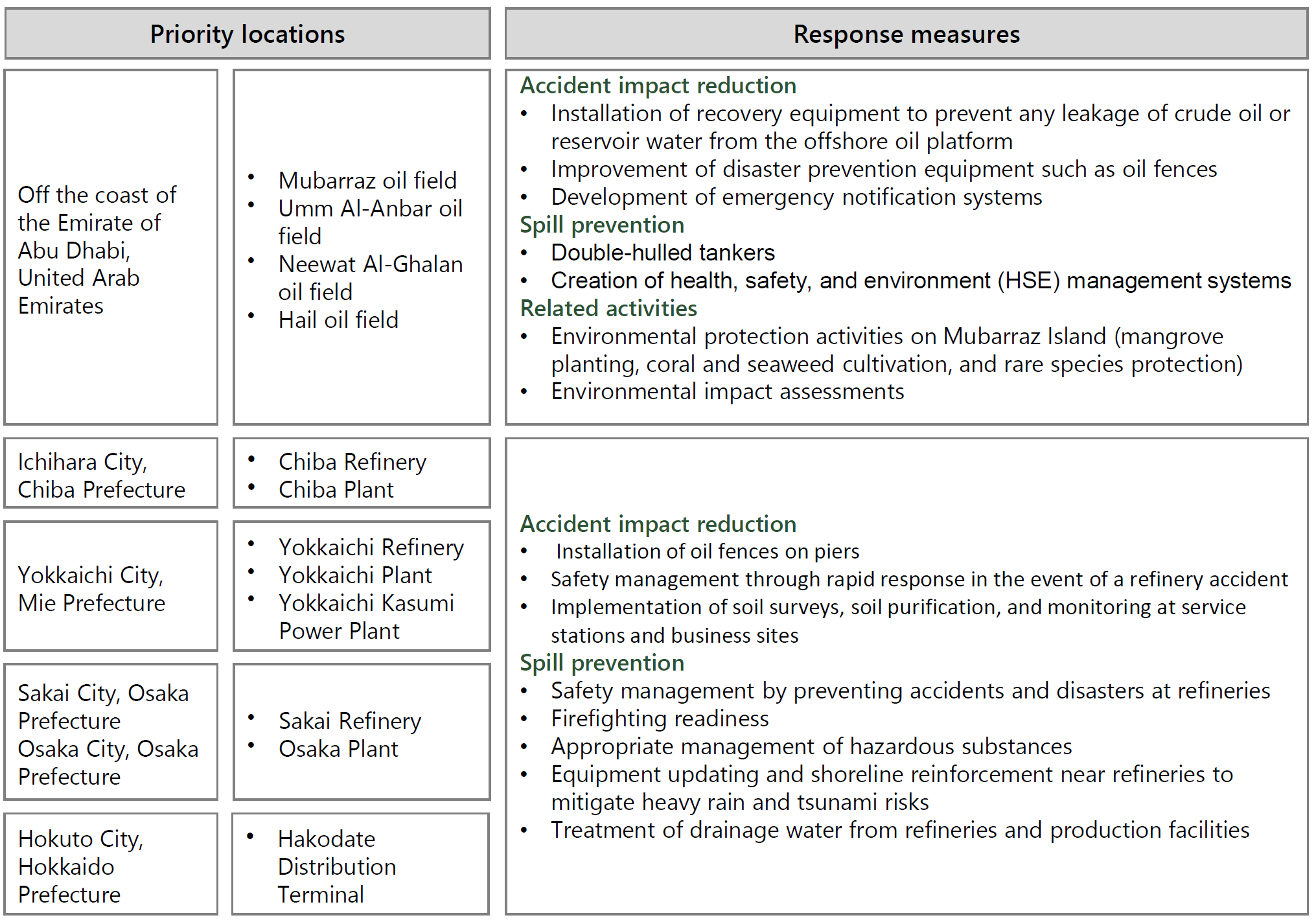
■ Measures for the Renewable Energy Business
In the renewable energy area, Cosmo Eco Power, which operates the Group’s wind power business, conducts legally required environmental assessments before starting any projects. After operations begin, follow-up surveys are carried out and environmental management is promoted according to the results of these assessments.
Based on this, we believe that our nature impact risks have been mitigated. If necessary, however, we will consider additional location analysis, and expand the scope of the business impact analysis.
Indicators and Targets
Quantitative Indicators
The Group recognizes climate change as one of its nature-related material issues, and has compiled and disclosed relevant indicators on its TCFD page.
Please refer to the link below for more information on indicators and targets.
Addressing Climate Change — Support for the TCFD Recommendations
■ TNFD’s Core Global Indicators
The TNFD recommends that companies select a total of 14 metrics as core global indicators. This includes nine indicators related to dependencies and impacts on nature, and five indicators related to nature-related risks and opportunities. Companies are also expected to release their indicator data.
The situation for disclosure of the Group’s core global dependency and impact indicators is described in the following section.
Core Global Dependency and Impact Indicators and Metrics
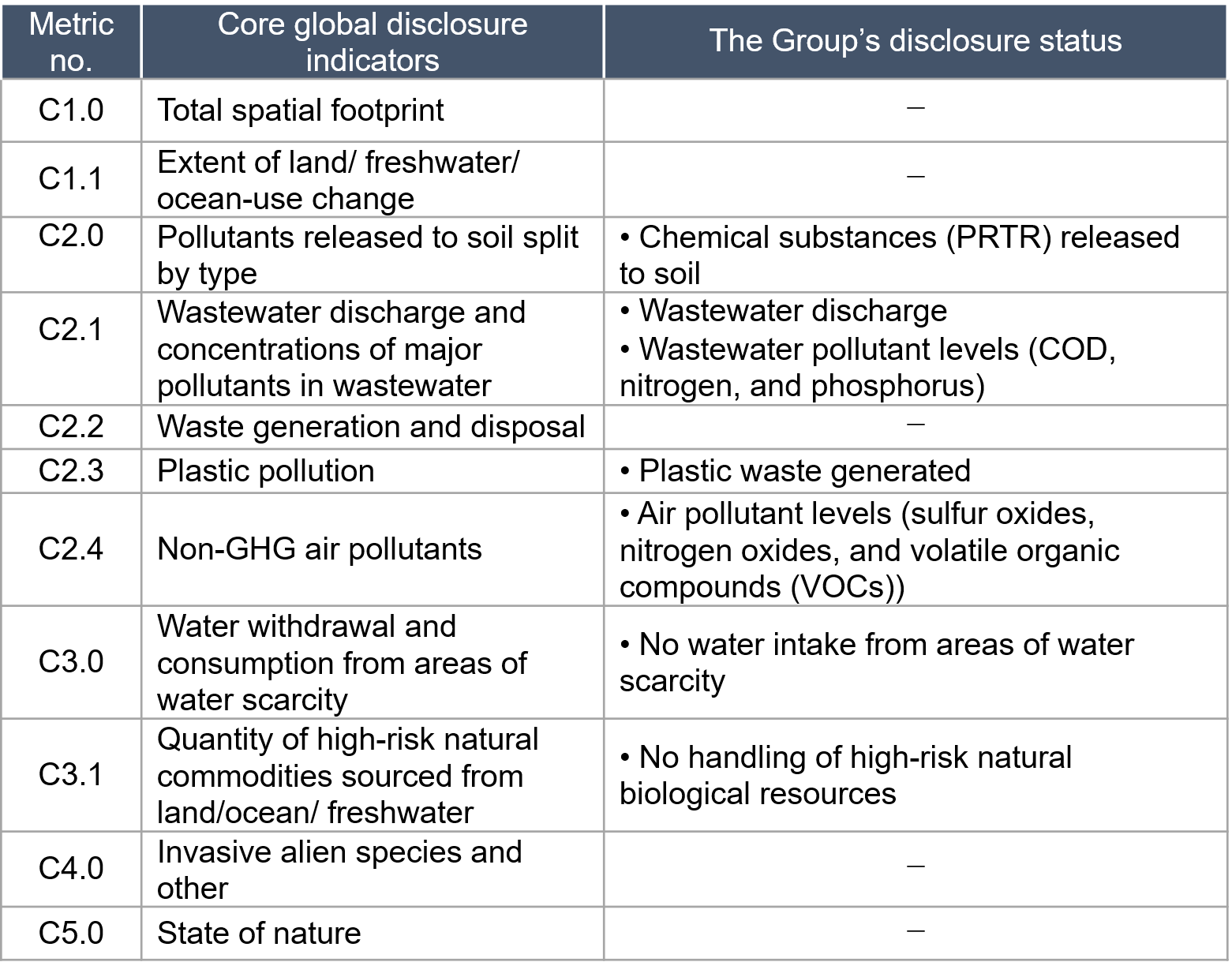
For indicators that are difficult to provide, we plan to expand disclosure by collecting data and conducting more detailed analysis. At the same time, we will also consider disclosing the core global indicators related to risks and opportunities in future surveys.
For information on our chemical substance management, wastewater discharge, and wastewater and air pollution levels, etc., please refer to “Initiatives for Reducing Environmental Impact.” For actual values, see the relevant items in ESG Data.
Quantitative Targets
■ Efforts to Help Achieve International Targets
Cosmo Energy Holdings has declared its support for the Keidanren Declaration for Biodiversity and Guideline. To fulfill the role of companies set out in this guideline, we are taking action to address the nine areas indicated.
Cosmo Energy Holdings joined the TNFD Forum in October 2023 and the 30by30 Alliance for Biodiversity launched by Japan’s Ministry of the Environment in November 2023.
The term “30 by 30” refers to the goal of effectively conserving 30% of the planet’s terrestrial and marine habitats by 2030. This is a nature-positive initiative that aims to halt the loss of biodiversity and to ensure a net positive impact on the natural environment.
Through our participation in this alliance, we will step up our efforts to conserve biodiversity and natural capital in order to help achieve the 30 by 30 goal.
We will also consider setting indicators and targets that are aligned with the TNFD’s core global dependency and impact indicators.
Environmental Protection Activities in Oil-Producing Countries
Cosmo Energy Exploration & Production is continually working to protect the environment and promote the sustainable use of natural resources.
Mubarraz Island, where Abu Dhabi Oil, a group company of Cosmo Energy Exploration & Production operates, has an extremely beautiful coastline that requires special environmental considerations. Based on an understanding of the responsibilities that come with working within a marine reserve, the company implements effective management and monitoring programs to protect the coastal ecosystem and the wildlife that depend on it.
At Mubarraz Island, which is a site for oil production, the company is also prioritizing and undertaking a wide range of environmental protection activities such as greening, including the planting of mangroves, coral reef farming, propagation of sea grass, and protection of a local osprey species.




Biodiversity Activities of the COSMO Eco Fund
With a commitment to conserving biodiversity, the COSMO Eco Fund supports projects such as rural Japanese landscape (satoyama) conservation activities and forest restoration projects where participants can learn about biodiversity.
For more details on these activities, please refer to the Project Introduction page for the COSMO Eco Fund.
